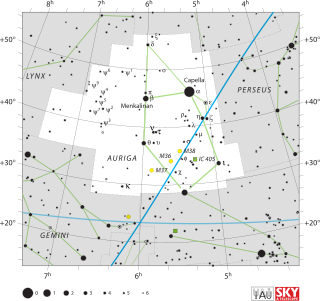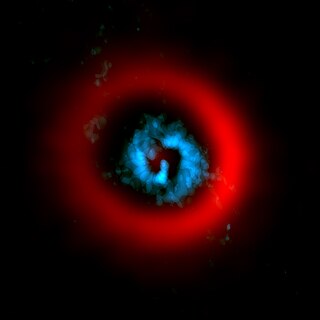Related Research Articles

Rolf Herman Nevanlinna was a Finnish mathematician who made significant contributions to complex analysis.

Auriga is a constellation in the northern celestial hemisphere. It is one of the 88 modern constellations; it was among the 48 constellations listed by the 2nd-century astronomer Ptolemy. Its name is Latin for '(the) charioteer', associating it with various mythological beings, including Erichthonius and Myrtilus. Auriga is most prominent during winter evenings in the northern Hemisphere, as are five other constellations that have stars in the Winter Hexagon asterism. Because of its northern declination, Auriga is only visible in its entirety as far south as -34°; for observers farther south it lies partially or fully below the horizon. A large constellation, with an area of 657 square degrees, it is half the size of the largest, Hydra.

The American Association of Variable Star Observers (AAVSO) is an international nonprofit organization. Founded in 1911, the organization focuses on coordinating, analyzing, publishing, and archiving variable star observations made largely by amateur astronomers. The AAVSO creates records that establish light curves depicting the variation in brightness of a star over time. The AAVSO makes these records available to professional astronomers, researchers, and educators.
Ellen Dorrit Hoffleit was an American senior research astronomer at Yale University. She is best known for her work in variable stars, astrometry, spectroscopy, meteors, and the Bright Star Catalog. She is also known for her mentorship of many young women and generations of astronomers.

Franz Friedrich Ernst Brünnow was a German astronomer.
The British Astronomical Association (BAA) was formed in 1890 as a national body to support the UK's amateur astronomers.

Capella is the brightest star in the northern constellation of Auriga. It has the Bayer designation α Aurigae, which is Latinised to Alpha Aurigae and abbreviated Alpha Aur or α Aur. Capella is the sixth-brightest star in the night sky, and the third-brightest in the northern celestial hemisphere after Arcturus and Vega. A prominent object in the northern winter sky, it is circumpolar to observers north of 44°N. Its name meaning "little goat" in Latin, Capella depicted the goat Amalthea that suckled Zeus in classical mythology. Capella is relatively close, at 42.9 light-years (13.2 pc) from the Sun. It is one of the brightest X-ray sources in the sky, thought to come primarily from the corona of Capella Aa.

Epsilon Aurigae is a multiple star system in the northern constellation of Auriga, the charioteer. It is an unusual eclipsing binary system comprising an F0 supergiant and a companion which is generally accepted to be a huge dark disk orbiting an unknown object, possibly a binary system of two small B-type stars. The distance to the system is still a subject of debate, but data from the Gaia spacecraft puts its distance at around 1,350±300 light years from Earth.

Zeta Aurigae, or ζ Aurigae, is a binary star system in the northern constellation of Auriga. Based upon parallax measurements made during the Hipparcos mission, this system is approximately 790 light-years distant from the sun. It has a combined apparent visual magnitude of 3.75, which is bright enough to be seen with the naked eye.

T Aurigae was a nova, which lit up in the constellation Auriga in 1891. Thomas David Anderson, an amateur astronomer in Edinburgh, reported that he was "almost certain" he saw the nova at 02:00 UT on 24 January 1892, when it was slightly brighter than χ Aurigae. He mistook the star for 26 Aurigae, although he noted to himself that it seemed brighter than he remembered it being. He saw it twice more during the following week. On 31 January 1892 he realized his mistake, and wrote a note to Ralph Copeland reporting his discovery. Professor Copeland immediately reported the discovery via telegram to William Huggins, who made the first spectroscopic observations of T Aurigae on 2 February 1892, when the star was a magnitude 4.5 object. T Aurigae was the first nova to be observed spectroscopically.

Eta Aurigae, officially named Haedus, is a star in the northern constellation of Auriga. With an apparent visual magnitude of 3.18, it is visible to the naked eye. Based upon parallax measurements made during the Hipparcos mission, this star is approximately 243 light-years distant from the Sun.

Hermann Alexander Brück CBE FRSE was a German-born astronomer, who spent the great portion of his career in various positions in Britain and Ireland.
Wilfried Hermann Georg Struve (1914–1992) was a German scientist. He started his career as a sixth-generation astronomer, a direct successor in the famous family line of Friedrich Georg Wilhelm, Otto Wilhelm, Hermann, Georg Hermann Struve. He fought for Germany in World War II and after the war changed his field from astronomy to acoustics.

AB Aurigae is a young Herbig Ae star in the Auriga constellation. It is located at a distance of approximately 531 light years from the Sun based on stellar parallax. This pre-main-sequence star has a stellar classification of A0Ve, matching an A-type main-sequence star with emission lines in the spectrum. It has 2.4 times the mass of the Sun and is radiating 38 times the Sun's luminosity from its photosphere at an effective temperature of 9,772 K. The radio emission from the system suggests the presence of a thermal jet originating from the star with a velocity of 300 km s−1. This is causing an estimated mass loss of 1.7×10−8 M☉ yr−1.
Mary Acworth Evershed was a British astronomer and scholar. Her work on Dante Alighieri was written under the pen name M.A. Orr. Although her middle name is increasingly appearing as Ackworth, this is incorrect. She always gave it as Acworth, and it appeared as such in both her obituaries. The one appearing in the Monthly Notices of the Royal Astronomical Society was written by her nephew A. David Thackeray, who presumably would have known. The first appearance of this incorrect version could well have occurred in the proposal of Mary to be a Fellow of the Royal Astronomical Society; the correct spelling appears when she was subsequently elected a Fellow.
Mary Teresa Brück was an Irish astronomer, astrophysicist and historian of science, whose career was spent at Dunsink Observatory in Dublin and the Royal Observatory Edinburgh in Scotland.

John Charles Duncan was an American astronomer.
Merle Eleanor Gold was an American astrophysicist, best known for her study of the Sun with Nobel Laureate Subrahmanyan Chandrasekhar.
Ileana Chinnici is an Italian historian of astronomy, book author, and biographer, whose biography of Angelo Secchi won the 2021 Osterbrock Book Prize of the American Astronomical Society.

Demetrios Kokkidis was an astronomer, mathematician, physicist, professor, and dean. Kokkidis was the fourth president of the Athens Observatory after the death of Johann Friedrich Julius Schmidt. He was one of the few Greek astronomers of the 20th century following Georgios Konstantinos Vouris and Ioannis Papadakis. He did extensive research and wrote articles about Mercury, the Sun, the Moon, and various meteorological phenomena.
References
- ↑ "DHM, Bildberichterstatterin, Dr. Margarete Gussow (1896- )". www.dhm.de. Retrieved 2022-05-07.
- ↑ "Margarete Güssow - The Mathematics Genealogy Project". www.genealogy.math.ndsu.nodak.edu. Retrieved 2022-05-05.
- ↑ "2000JAHH....3..176H Page 176". adsabs.harvard.edu. Bibcode:2000JAHH....3..176H . Retrieved 2022-05-06.
- ↑ Güssow, M. (1936-01-01). "Epsilon Aurigae". Veroeffentlichungen der Universitaetssternwarte zu Berlin-Babelsberg. 11: B1–B36. Bibcode:1936VeBB...11B...1G.
- ↑ "Site de Francois Delpla :Les femmes ont-elles nazies ?". www.delpla.org. Retrieved 2022-05-04.
- 1 2 "Historisk astronomi De var Hitlers astronomer" (PDF). www.popularastronomi.se.